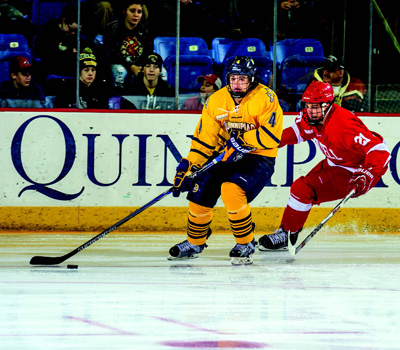Oct 20, 2017Skating Strong, Part I
Here at Quinnipiac University, we emphasize a strong start to the season. And the secret to having a strong start is a solid preseason training regimen. Ours ties into our offseason program and sets the stage for the subsequent competitive slate. Typically lasting five weeks, the goal for the preseason is improving players’ specific conditioning and work capacity, and I make sure everything we do directly carries over to the ice.
Our offseason training is composed of three main phases: General Physical Preparedness (GPP), Special Physical Preparedness (SpPP), and Specific Physical Preparedness (SPP). I think of preparedness like a tree. The roots of the tree are the general qualities (GPP) that we develop. They have to be strong and deep in order to support the rest of the tree.
The trunk is made up of the special qualities (SpPP) that we reinforce during the preseason. These improve athletes’ abilities to perform specific sport skills more efficiently and at a higher speed/rate.

That brings us to the branches and leaves, which are the specific sport skills (SPP). When you have deep roots and a strong trunk, the potential to improve these skills is much greater.
During GPP, the goal is to develop the physical qualities needed for ice hockey, and our program consists primarily of general training to improve strength, endurance, flexibility, mobility, stability, and coordination.
As our offseason progresses, we incorporate more SpPP work, which serves as a bridge between GPP and SPP. A lot of our preseason is spent in this phase. We aim to use the physical qualities developed in GPP to improve athletes’ motor potential and support the sport skills they’ll need in SPP — specifically speed, power, and movement skills.
Much of what I do during SpPP incorporates “special strength training,” a practice I’ve adopted from the former Soviet Union. Coaches there took preparing for athletics very seriously and developed many unique methods that are still valid today.
The final stage in the offseason is SPP work, which prepares athletes for specific hockey movements. At this stage, our athletes start to increase the amount of time they spend on the ice. Training during this stage incorporates actions specific to the sport that can only be learned through repetition.
I deliberately avoid using the term “sport specific” when describing any of the movements and exercises we do throughout the offseason and preseason. I am a firm believer that strength coaches are not able to do anything truly sport specific in the weightroom, since we do not train the skills of the game. Although some of the characteristics we focus on can be specific to a sport, that’s a different term and a key point to understand.
Honing in specifically on the preseason, the exercises in our SpPP phase are selected to enhance athletes’ motor potential and efficiency of movements, ensuring that most of their energy is directed toward developing the skills of the game. Therefore, we are careful about choosing and coaching our movements.
We start with a sport analysis. Trying to think as specifically as possible, we always ask ourselves: “How is this exercise similar to a hockey movement?” The primary drivers of our choices are the motions that occur on the ice, as well as the muscle actions (eccentric, isometric, concentric) and how they function, common injuries, the time to apply force (long versus short), and planes of movement.
In addition, we apply the Principle of Dynamic Correspondence from Mel Siff and Yuri Verkhoshansky. This concept emphasizes that exercises should be chosen to enhance a specific sport’s required motor qualities and movement patterns in several areas:
• Muscle groups involved in the exercise
• Amplitude and direction of movement
• Accentuated part of force production
• Rate and time of maximum force production
• Regimen of muscular work.
Factoring in all of these criteria, our primary SpPP exercises include plyometrics, loaded jumps, and linear and lateral movement drills. These replicate the same angles, joint positions, and velocities that occur on the ice. By completing these exercises, our athletes learn how to produce and apply force to optimally project their bodies.
Next week, we’ll detail the specific exercises used in the preseason plan.



